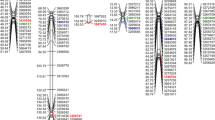Summary
The effects on quantitative characters of the ml-o5 allele has been investigated by means of doubled haploid lines produced by the Hordeum bulbosum method. In one series of experiments the genetic background in each cross was found significantly to modify the negative pleiotropic effects. Doubled haploids were also produced from a F1 cross and tested in the field during two years, one with strong and one with weak mildew infections. In the first year only an insignificant reduction in grain yield was detected in the mlo lines, in the second it was significantly reduced with 5.9%. Thousand grain weights were, however, higher in the resistant lines. In both series of experiments the possibility to extract very high yielding mlo genotypes was demonstrated. The nature of the genetic background effect is discussed.
Similar content being viewed by others
References
Allard, R.W., 1988. Genetic changes associated with the evolution of adoptedness in cultivated plants and their wild progenitors. J. Hered. 79: 225–238.
Balasaraswathi, R., B.Køie, H.Doll, 1984. The concentration and yield of hordein and some lysine rich proteins as influenced by the lys gene of Hiproly barley. Hereditas 100: 225–231.
Beck, C. & J.Helms Jørgensen, 1986. Screening of European spring barley varieties for reactions to net blotch. Nordisk Jordbrugsforskning 68(3): 344.
Bjørnstad, Å., 1986. Partial incompatibility between Scandianvian six-rowed barleys (Hordeum vulgare L.) and Hordeum bulbosum L. and its genetical basis. Hereditas 104: 171–191.
Bjørnstad, Å., 1987. The role of linkage and pleiotropy in doubled haploid lines from a barley cross. Hereditas 106: 155–168.
Choo, T.M., 1981. Doubled haploids for studying the inheritance of quantitative characters. Genetics 99: 525–540.
Freisleben, R. & A.Lein, 1942. Über die Auffindung einer mehltauresistenten Mutante nach Röntgenbestrahlung einer anfälligen reinen Linie von Sommergerste.-Naturwissenschaften 30: 608.
Jørgensen, J. Helms., 1976. Identification of powdery mildew resistant barley mutants and their allelic relationship.-Barley Genetics III: 446–455.
Jørgensen, J. Helms, 1984. Durability of the ml-o powdery mildew resistance genes in barley. Vortr. Pflanzenzuchtg. 6: 22–31.
Jørgensen, J. Helms, 1987. Three kinds of powdery mildew resistance in barley. Barley Genetics V: 583–592.
Knudsen, J.C.N., H.H.Dalsgaard & J.Helms Jørgensen, 1987. Partial resistance to barley powdery mildew. Barley Genetics V: 645–650.
Kjær, B., H.P. Jensen, J. Jensen & J. Helms Jørgensen, 1989a. Associations between three ml-o powdery mildew resistance genes and agronomic traits in barley. Euphytica (in press).
Kjær, B., V. Haahr & J. Jensen, 1989b. Associations in a barley cross between ten genetic markers and twenty-three quantitative traits. Plant Breeding (in press).
Powell, W., P.D.S.Caligari, W.T.B.Thomas & J.L.Jinks, 1985. The effects of major genes on quantitatively varying characters in barley. 2. The denso and daylength response loci. Heredity 54: 349–352.
Schwarzbach, E. 1976. The pleiotropic effects of the ml-o gene and their implications in breeding.-Barley Genetics III: 440–445.
Reinbergs, E., S.J.Park & L.S.P.Song, 1976. Early identification of superior barley crosses by the doubled haploid technique. S. Pflanzenzuchtg. 76: 215–224.
Snape, J.W.E.Simpson, 1981. The genetical expectations of doubled haploid lines derived from different filial generations. Theor. Appl. Genet. 60: 123–128.
Stølen, O., P.Kølster & L.Munk, 1987. Multilines and mixtures of cultivars in barley. Barley genetics V: 601–606.
Author information
Authors and Affiliations
Rights and permissions
About this article
Cite this article
Bjørnstad, Å., Aastveit, K. Pleiotropic effects on the ml-o mildew resistance gene in barley in different genetical backgrounds. Euphytica 46, 217–226 (1990). https://doi.org/10.1007/BF00027221
Received:
Accepted:
Issue Date:
DOI: https://doi.org/10.1007/BF00027221



